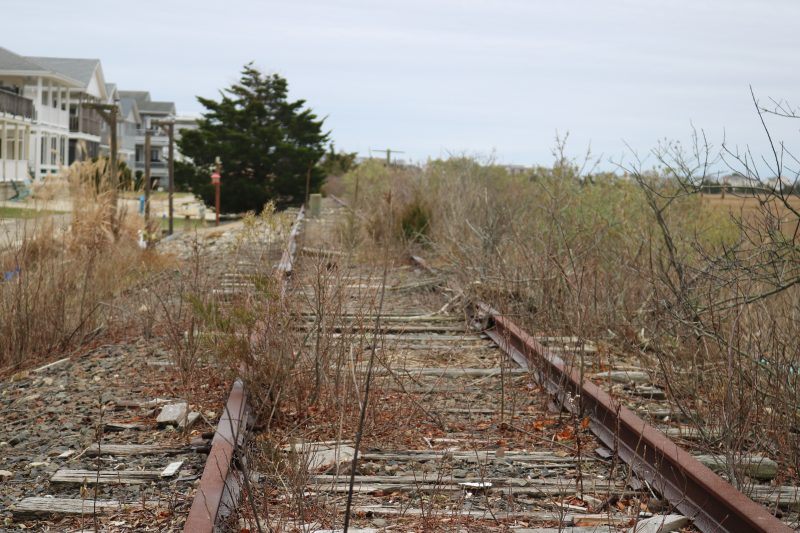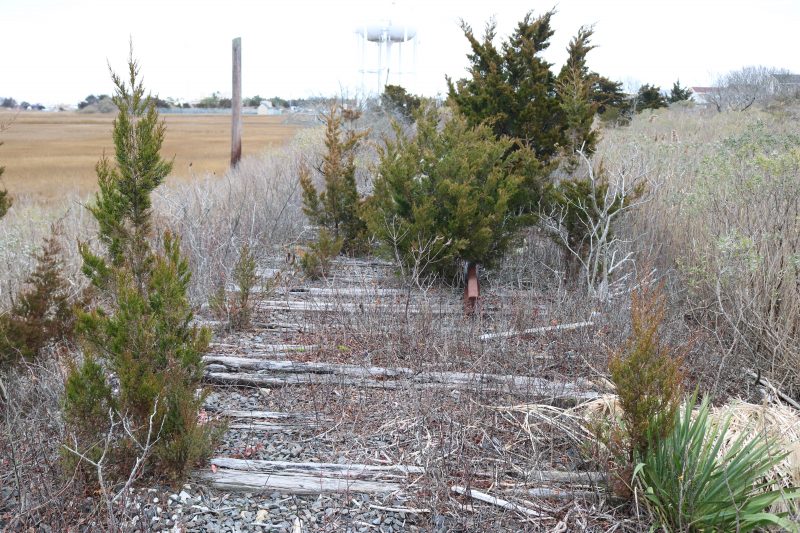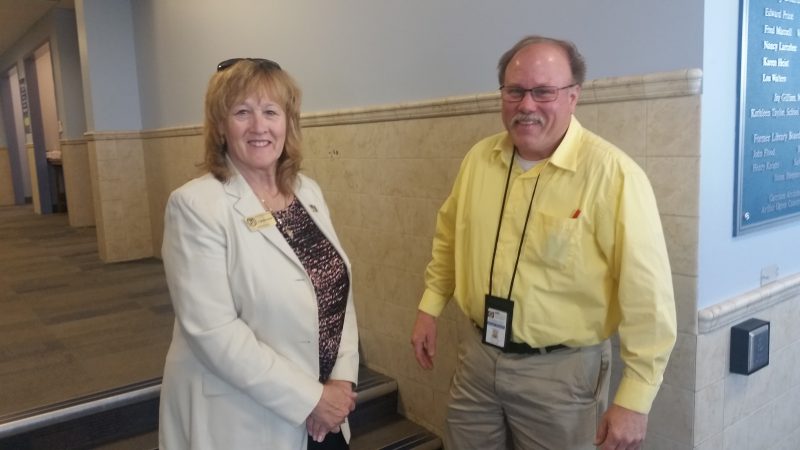Cape May County Freeholder E. Marie Hayes and Cape May County Engineer Bob Church attended the Fourth Ward meeting.
 By Donald Wittkowski
Ocean City Fourth Ward Councilman Bob Barr calls it the “large fix.”
As the city continues to search for ways to fight flooding, one massive project under consideration would involve transforming an abandoned railroad bed into a barrier to block stormwater rushing in from the bay.
“This is the large fix,” Barr told local residents Saturday during a Fourth Ward community meeting held at the Ocean City Free Public Library.
Barr, joined by Cape May County Freeholder E. Marie Hayes and Cape May County Engineer Bob Church, talked about a number of drainage and road projects in town, but the one that dominated the discussion was the possibility of using the old railroad embankment as a flood barrier.
“What they’re talking about is a massive project for almost the entire ward,” Barr said. “If they’re able to pull it off, I think everyone will be happy.”
The proposed project would stretch from 36th to 59th streets through the Fourth Ward neighborhoods in the southern tip of the barrier island. Principally, it would involve converting the ghostly remnants of railroad tracks that were abandoned years ago into a barrier about 11,000 feet long.
ACT Engineers Inc., a consulting firm for the city, is conducting a $45,000 study that will explore the possibility of reinforcing the old railroad embankment to create a “resiliency berm” to protect homeowners from floodwaters flowing out of the marshlands and back bays.
“It would be a (project) to build a barrier, basically, to hold the water back,” Barr explained to the residents.
Barr said Mayor Jay Gillian and ACT Engineers are expected to hold a town hall meeting with residents in late summer or early fall to describe the proposed project in more detail.
By Donald Wittkowski
Ocean City Fourth Ward Councilman Bob Barr calls it the “large fix.”
As the city continues to search for ways to fight flooding, one massive project under consideration would involve transforming an abandoned railroad bed into a barrier to block stormwater rushing in from the bay.
“This is the large fix,” Barr told local residents Saturday during a Fourth Ward community meeting held at the Ocean City Free Public Library.
Barr, joined by Cape May County Freeholder E. Marie Hayes and Cape May County Engineer Bob Church, talked about a number of drainage and road projects in town, but the one that dominated the discussion was the possibility of using the old railroad embankment as a flood barrier.
“What they’re talking about is a massive project for almost the entire ward,” Barr said. “If they’re able to pull it off, I think everyone will be happy.”
The proposed project would stretch from 36th to 59th streets through the Fourth Ward neighborhoods in the southern tip of the barrier island. Principally, it would involve converting the ghostly remnants of railroad tracks that were abandoned years ago into a barrier about 11,000 feet long.
ACT Engineers Inc., a consulting firm for the city, is conducting a $45,000 study that will explore the possibility of reinforcing the old railroad embankment to create a “resiliency berm” to protect homeowners from floodwaters flowing out of the marshlands and back bays.
“It would be a (project) to build a barrier, basically, to hold the water back,” Barr explained to the residents.
Barr said Mayor Jay Gillian and ACT Engineers are expected to hold a town hall meeting with residents in late summer or early fall to describe the proposed project in more detail.
 Weeds, bushes and trees are overrunning the rotted wooden railroad ties.
Currently, the rusty old steel railroad tracks that once carried train passengers to the beach resort are overrun by weeds and bushes. Trees have even sprouted between the crumbling wooden railroad ties.
As city officials continue to consider different concepts to reduce flooding on the low-lying island, the old railroad bed presents itself as an intriguing option. Train service in Ocean City was halted decades ago, but the embankment that supported the tracks still remains.
ACT Engineers did not have a representative at Saturday’s meeting, but the company’s vice president, Eric Rosina, said in an interview in December that the flood barrier would likely cost millions of dollars if it proves feasible.
Weeds, bushes and trees are overrunning the rotted wooden railroad ties.
Currently, the rusty old steel railroad tracks that once carried train passengers to the beach resort are overrun by weeds and bushes. Trees have even sprouted between the crumbling wooden railroad ties.
As city officials continue to consider different concepts to reduce flooding on the low-lying island, the old railroad bed presents itself as an intriguing option. Train service in Ocean City was halted decades ago, but the embankment that supported the tracks still remains.
ACT Engineers did not have a representative at Saturday’s meeting, but the company’s vice president, Eric Rosina, said in an interview in December that the flood barrier would likely cost millions of dollars if it proves feasible.
 Cape May County Freeholder E. Marie Hayes and Cape May County Engineer Bob Church attended the Fourth Ward meeting.
Underscoring the bureaucratic perils, Barr said the New Jersey Department of Environmental Protection earlier had approved a $2 million state grant for the proposed storm barrier, but later withdrew the funding after Ocean City and the agency couldn’t reach an agreement for the project.
“It was really disappointing that the grant was taken away,” Barr said.
In the December interview, Rosina explained there are environmental challenges to be considered in building a flood barrier using the railroad embankment. While such a barrier could protect homes from flooding, the city would have to be careful not to cut off the ecologically sensitive wetlands from the back-bay waters that feed them, he said.
Rosina pointed out that there are some gaps in the embankment that allow floodwater to invade the south end neighborhoods. ACT Engineers will study whether the embankment can be reinforced in some way to block the flooding.
A new barrier created out of the remnants of the old railroad embankment is just one part of a broader flood-control strategy under consideration by city officials. Drainage improvements, pumping stations and road construction are the types of flood-mitigation projects that have been used across town.
One major project involves $6.5 million worth of road and drainage construction in the Fourth Ward neighborhoods between 28th and 34th streets, from West Avenue to the bay. Barr hailed it as a success, but added that some final touches remain before the project is completely done.
“By and large, I think folks are pretty happy with the way the project is working,” he said. “I’ve heard very few complaints.
One resident at the meeting, John De Petris, a homeowner at 2940 Simpson Ave., told Barr that the project has stopped the flooding in front of his house. However, De Petris is still waiting for work to be finished to control the flooding that occurs in the back alley near his home.
“They did a good job with the project,” De Petris said in an interview after the meeting. “The whole area is a great, great improvement. When they fix the back alley, it will be 100 percent.”
Cape May County Freeholder E. Marie Hayes and Cape May County Engineer Bob Church attended the Fourth Ward meeting.
Underscoring the bureaucratic perils, Barr said the New Jersey Department of Environmental Protection earlier had approved a $2 million state grant for the proposed storm barrier, but later withdrew the funding after Ocean City and the agency couldn’t reach an agreement for the project.
“It was really disappointing that the grant was taken away,” Barr said.
In the December interview, Rosina explained there are environmental challenges to be considered in building a flood barrier using the railroad embankment. While such a barrier could protect homes from flooding, the city would have to be careful not to cut off the ecologically sensitive wetlands from the back-bay waters that feed them, he said.
Rosina pointed out that there are some gaps in the embankment that allow floodwater to invade the south end neighborhoods. ACT Engineers will study whether the embankment can be reinforced in some way to block the flooding.
A new barrier created out of the remnants of the old railroad embankment is just one part of a broader flood-control strategy under consideration by city officials. Drainage improvements, pumping stations and road construction are the types of flood-mitigation projects that have been used across town.
One major project involves $6.5 million worth of road and drainage construction in the Fourth Ward neighborhoods between 28th and 34th streets, from West Avenue to the bay. Barr hailed it as a success, but added that some final touches remain before the project is completely done.
“By and large, I think folks are pretty happy with the way the project is working,” he said. “I’ve heard very few complaints.
One resident at the meeting, John De Petris, a homeowner at 2940 Simpson Ave., told Barr that the project has stopped the flooding in front of his house. However, De Petris is still waiting for work to be finished to control the flooding that occurs in the back alley near his home.
“They did a good job with the project,” De Petris said in an interview after the meeting. “The whole area is a great, great improvement. When they fix the back alley, it will be 100 percent.”
 Councilman Bob Barr says the city's flood-control projects appear to be working.
Councilman Bob Barr says the city's flood-control projects appear to be working.